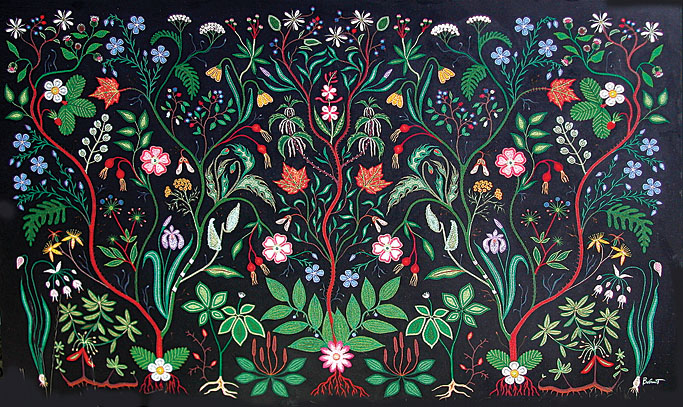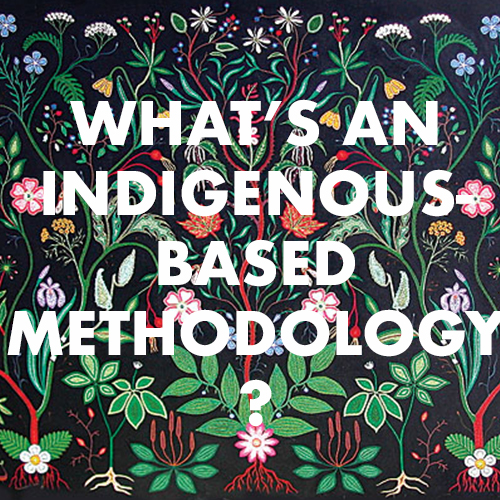
WHAT’S AN INDIGENOUS-BASED METHODOLOGY?
heather ahtone (Choctaw and Chickasaw). “Reading Beneath the Surface: Joe Feddersen’s Parking Lot.” Wicazo Sa Review, vol. 27, no. 1, 2012, p. 73-84. www.jstor.org/stable/10.5749/wicazosareview.27.1.0073.
“Reading Beneath the Surface” demonstrates the possibility and actuality of doing ethical art history, specifically in the field of art by Indigenous peoples, while also showing that different types of art require different tools for assessment. ahtone does not suggest that art historians utilize this methodology when looking at non-Indigenous art. In fact, she is not interested in the methods they take in dealing with this work. This highly focused approach is responsible because it designates space specifically for Native people, who have traditionally been excluded from the the field of art history, while also maintaining that their experiences and therefore their creative practices are necessarily different than those of non-Indigenous peoples. Thus, their work should be treated as such and requires different methodological tools for study.
To ahtone’s mind, an “Indigenous-based methodology” is rooted in “cultural reciprocity” (74) and pays close attention to an object’s materiality, as well as its maker’s life and cultural identity. This methodology shows that “more is present in Feddersen’s work than is accessible through a Western art historical approach” (75). Through a close-reading of Parking Lot, ahtone demonstrates not just the feasibility of her method, but also its necessity for getting to answers that are otherwise inaccessible using a traditional Western art historical methodology.
VISUAL SOVEREIGNTY
Rickard, Jolene (Tuscarora). “Sovereignty: A Line in the Sand.” Aperture, no. 139, 1995, p. 50-59.
How is this practiced?
INDIGENOUS-BASED CURATORIAL PRACTICE
by Indians, about Indians, informed by Indianness
“A Conversation About ‘Americans.'” YouTube, uploaded by Smithsonian NMAI, 2 February 2018, https://youtu.be/Td–OkcSO3k. Gerald McMaster (Plains Cree/Member of the Siksika First Nation) moderates a discussion between curators of “Americans” at NMAI, Paul Chaat Smith (Comanche) and Cécile R. Ganteaume, and Director of NMAI, Kevin Gover (Pawnee).
McMaster, Gerald R. “INDIGENA: A Native Curator’s Perspective,.” Art Journal, vol. 51, no. 3, 1992, pp. 66–73. www.jstor.org/stable/777350. McMaster reflects on the 1992 show, “INDIGENA: Perspectives of Indigenous Peoples on Five Hundred Years” at the Canadian Museum of Civilization (now Canadian Museum of History).
Who holds power in an institution? Which institutions? What’s the difference between amplifying voices through inclusion and granting material decision-making power?
ART-MAKING
Simpson, Leanne Betasamosake (Michi Saagiig Nishnaabeg). “Embodied Resurgent Practice and Coded Disruption.” In As We Have Always Done: Indigenous Freedom through Radical Resistance, 191-210. Minneapolis; London: University of Minnesota Press, 2017. http://www.jstor.org/stable/10.5749/j.ctt1pwt77c.14.
Martineau, Jarrett (nêhiyaw [Plains Cree] and Dene Suline from Frog Lake First Nation in Alberta) and Ritskes, Eric. “Fugitive indigeneity: Reclaiming the terrain of decolonial struggle through Indigenous art.” Decolonization: Indigeneity, Education, & Society, Vol. 3, No. 1, 2014, p. I-XII.
